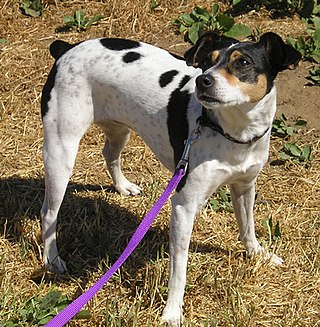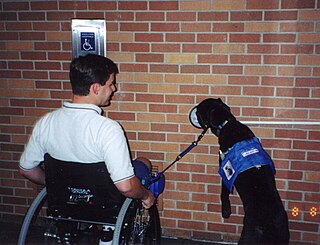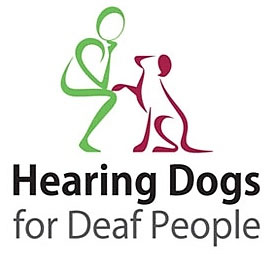
Guide dogs are assistance dogs trained to lead blind or visually impaired people around obstacles. Although dogs can be trained to navigate various obstacles, they are red–green colour blind and incapable of interpreting street signs. The human does the directing, based on skills acquired through previous mobility training. The handler might be likened to an aircraft's navigator, who must know how to get from one place to another, and the dog is the pilot, who gets them there safely. In several countries guide dogs, along with most other service and hearing dogs, are exempt from regulations against the presence of animals in places such as restaurants and public transportation.

An assistance dog, known as a service dog in the United States, is a dog trained to aid or assist an individual with a disability. Many assistance dogs receive training from a handler or from an assistance dog organization.

A retriever is a type of gun dog that retrieves game for a hunter. Generally gun dogs are divided into three major classifications: retrievers, flushing spaniels, and pointing breeds. Retrievers were bred primarily to retrieve birds or other prey and return them to the hunter without damage; retrievers are distinguished in that nonslip retrieval is their primary function. As a result, retriever breeds are bred for soft mouths and a great willingness to please, learn, and obey. A soft mouth refers to the willingness of the dog to carry game in its mouth without biting into it. "Hard mouth" is a serious fault in a hunting dog and is very difficult to correct. A hard-mouthed dog renders game unpresentable or at worst inedible.

Gun dogs or bird dogs are types of hunting dogs developed to assist hunters in finding and retrieving game, typically various fowls that are shot down on the flight. The term hunting dog is broad and includes all breeds and skills of hunting canines, but "gun dogs" refers to canines that are trained to work alongside a loud firearm while hunting or retrieving game. Gun dogs are divided into three main categories: pointers and retrievers, setters and spaniels, and water dogs.

A police dog, also known as a K-9, is a dog that is trained to assist police and other law enforcement officers. Their duties may include searching for drugs and explosives, locating missing people, finding crime scene evidence, protecting officers and other people, and attacking suspects who flee from officers. The breeds most commonly used by law enforcement are the German Shepherd, Belgian Malinois, Bloodhound, Dutch Shepherd, and Labrador Retriever. In recent years, the Belgian Malinois has become the leading choice for police and military work due to their intense drive, focus, agility, and smaller size, though German Shepherds remain the breed most associated with law enforcement.

A leash is a rope or similar material used to control an animal by attaching it to a collar, harness, or halter. In British English, a leash is generally for a larger animal, with lead being more commonly used when walking a dog.
A dog collar is a piece of material put around the neck of a dog. A collar may be used for restraint, identification, fashion, protection, or training. Identification tags and medical information are often placed on dog collars. Collars are often used in conjunction with a leash for restraining a dog. Collars can be traumatic to the trachea if the dog pulls against the restraint of the leash, causing severe pressure to the neck. Use of a harness instead of a collar may be beneficial for dogs prone to tracheitis or those with a collapsed trachea. Conversely, dog breeds with slender necks or smaller heads may easily slip out of collars that are too loose. This can be avoided by using a martingale dog collar which tightens to distribute pressure around the neck when training the dog not to pull. Any style of dog collar must be properly fitted to ensure safety and collars should not be worn when the dog is unattended.
Dog showmanship is a set of skills and etiquette used by handlers of dogs in a dog competition. Dog showmanship is not a competition in itself but a qualification of the handler to present a dog to its best advantage. Skills are technical as well as artistic. A handler must groom and display the dog for a judge in specific ways but a true showman can accentuate the best features of the dog and even mask any faults. Many professional handlers train and condition the dogs they accept into their program as they see fit. This means that dogs owned by others are away from home with their handlers for months at a time. Professional showmen may handle dogs as a sole source of income.

Canines, Canis familiaris, perform many essential roles within society, most notably in the fields of assistance, therapy, detection, and protection. Falling within the field of detection, a search-and-rescue (SAR) dog is one trained to respond to crime scenes, accidents, missing persons events, as well as natural or man-made disasters. These dogs detect human scent, which is a distinct odor of skin flakes and water and oil secretions unique to each person and have been known to find people underwater, snow, and collapsed buildings, as well as remains buried underground. SAR dogs are a non-invasive aid in the location of humans, alive or deceased.

An autism assistance dog or autism service dog is an assistance dog trained to assist an autistic person manage their disability and live more independently.

A cape, jacket, or vest is an article worn by a working dog to identify or assist them in their job.
A psychiatric assistance dog or psychiatric service dog is a sub-category of assistance dog trained to assist their handler with a psychiatric disability or a mental disability, such as obsessive-compulsive disorder, post-traumatic stress disorder, schizophrenia, depression, anxiety, and bipolar disorder.
Canine Companions for Independence is a US-based 501(c)(3) nonprofit organization that trains and provides assistance dogs. As of 2018, it has placed over 6,000 assistance dogs with recipients at no charge.

Guiding Eyes for the Blind is a non-profit school based in Yorktown Heights, New York that trains guide dogs to aid people who are visually impaired. It also operates a canine development center in Patterson, New York, and a training site in White Plains, New York. It was the first guide dog training school to be accredited by the National Accreditation Council for Agencies Serving the Blind and Visually Handicapped.

A medical response dog is an assistance dog trained to assist an individual who has a medical disability. Typically, they are dogs whose job does not handle primarily epilepsy or psychiatric-based conditions, though some seizure response dogs or psychiatric service dogs may also be referred to as medical response.

Service animals are working animals that have been trained to perform tasks that assist disabled people. Service animals may also be referred to as assistance animals or helper animals depending on the country and the animal's function. Dogs are the most common service animals, having assisted people since at least 1927.

Hearing Dogs for Deaf People is a UK charity which trains dogs to alert deaf people to a variety of sounds.
NEADS Inc. is an American 501(c)(3) nonprofit program that provides trained service dogs to people who have physical disabilities or who are deaf or hearing impaired; veterans with PTSD; and children with autism or other developmental disabilities.

In the United States, a courthouse facility dog is a professionally trained facility dog that has graduated from an accredited assistance dog organization that is a member of Assistance Dogs International. Such dogs assist crime victims, witnesses and others during the investigation and prosecution of crimes, as well as during other legal proceedings. Courthouse facility dogs also provide assistance to Drug Court and Mental Health Court participants during their recovery from drugs, alcohol, mental illness and posttraumatic stress disorder.

The U.S. Military Working Dog Teams National Monument is a monument to military working dogs located at Joint Base San Antonio (JBSA)-Lackland in San Antonio, Texas. The monument represents handlers, dogs, and veterinary support, from all military service branches that have made up the Military Working Dog program since World War II. The monument grounds include a 3,000 square feet granite plaza, granite pedestals, granite history wall, granite benches and water fountain. The granite pedestals have large bronze statues of dogs and handlers. The monument was dedicated on October 28, 2013.

















